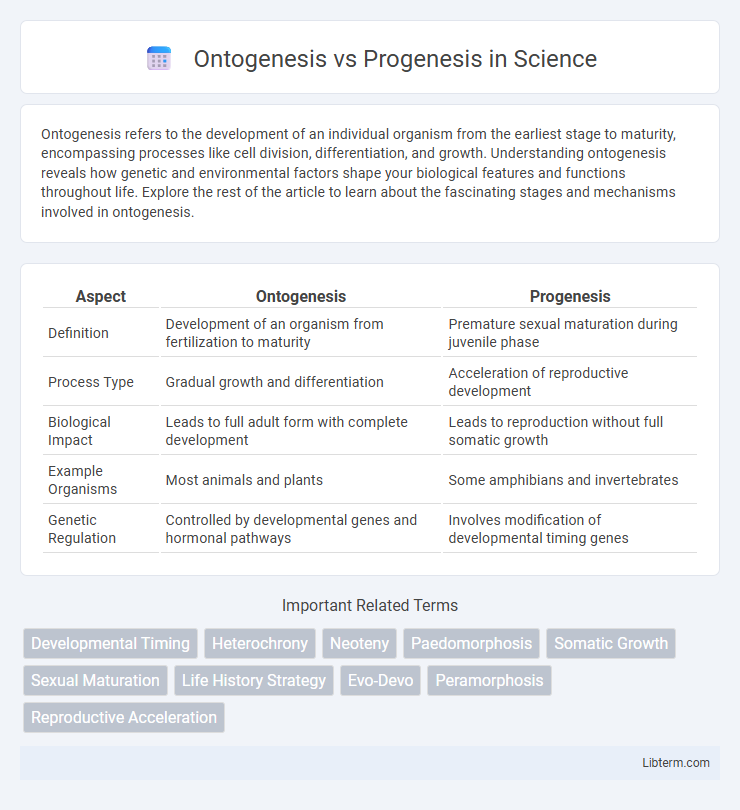Ontogenesis refers to the development of an individual organism from the earliest stage to maturity, encompassing processes like cell division, differentiation, and growth. Understanding ontogenesis reveals how genetic and environmental factors shape your biological features and functions throughout life. Explore the rest of the article to learn about the fascinating stages and mechanisms involved in ontogenesis.
Table of Comparison
| Aspect | Ontogenesis | Progenesis |
|---|---|---|
| Definition | Development of an organism from fertilization to maturity | Premature sexual maturation during juvenile phase |
| Process Type | Gradual growth and differentiation | Acceleration of reproductive development |
| Biological Impact | Leads to full adult form with complete development | Leads to reproduction without full somatic growth |
| Example Organisms | Most animals and plants | Some amphibians and invertebrates |
| Genetic Regulation | Controlled by developmental genes and hormonal pathways | Involves modification of developmental timing genes |
Introduction to Ontogenesis and Progenesis
Ontogenesis refers to the complete developmental process of an organism from fertilization to maturity, encompassing cellular differentiation, growth, and morphological changes. Progenesis, a form of heterochrony, occurs when an organism attains reproductive maturity earlier than usual, often resulting in a paedomorphic adult stage. Understanding the differences between ontogenesis and progenesis provides insights into evolutionary development, growth patterns, and species adaptation.
Defining Ontogenesis: Concept and Stages
Ontogenesis refers to the complete development process of an individual organism from fertilization to maturity, encompassing stages such as zygote formation, embryonic development, and post-embryonic growth. This biological sequence involves cellular differentiation, morphogenesis, and physiological maturation, which collectively ensure the organism attains its functional adult form. Understanding ontogenesis is crucial for distinguishing normal developmental progression from progenesis, where maturation is accelerated and reproductive capability arises prematurely.
Understanding Progenesis: Meaning and Mechanisms
Progenesis is a form of heterochrony where an organism reaches sexual maturity earlier than usual, resulting in a shortened developmental period. This process accelerates reproductive capability while retaining juvenile physical traits, significantly influencing evolutionary adaptations. Understanding progenesis involves analyzing genetic regulation, hormonal control, and environmental triggers that alter typical ontogenetic timelines, shifting growth patterns and developmental milestones.
Key Differences Between Ontogenesis and Progenesis
Ontogenesis refers to the complete development of an organism from fertilization to maturity, encompassing all stages of growth and differentiation, while progenesis is a form of heterochrony where an organism attains sexual maturity prematurely, resulting in a paedomorphic adult with juvenile characteristics. The key differences lie in ontogenesis representing the full developmental trajectory versus progenesis causing an early halt in somatic development concurrent with early reproductive capability. Progenesis alters life history strategies by truncating ontogenetic processes, impacting evolutionary adaptation and morphological traits.
Evolutionary Significance of Ontogenesis
Ontogenesis, the developmental process of an organism from fertilization to maturity, plays a crucial role in evolutionary biology by shaping phenotypic traits that influence survival and reproduction. Evolutionary significance of ontogenesis lies in its ability to generate developmental plasticity, enabling species to adapt to changing environments and promoting genetic diversity through varied developmental pathways. Progenesis, a form of heterochrony characterized by accelerated sexual maturation, contrasts with ontogenesis by truncating development, often affecting evolutionary trajectories by facilitating rapid reproductive cycles in certain ecological niches.
Adaptive Roles of Progenesis in Species
Progenesis accelerates reproductive maturity, enabling species to adapt rapidly to environmental pressures by shortening generation times and promoting early reproduction. This adaptive role enhances survival in unpredictable habitats by allowing quicker population turnover and genetic variation. Ontogenesis, in contrast, involves prolonged development, often optimizing complex traits but at the cost of slower reproductive rates.
Factors Influencing Ontogenesis and Progenesis
Factors influencing ontogenesis include genetic regulation, environmental conditions, and hormonal signaling pathways that guide an organism's development from embryo to adult. Progenesis is primarily affected by genetic mutations and environmental pressures that accelerate sexual maturation, truncating somatic growth. Both processes are modulated by epigenetic mechanisms that determine developmental timing and the balance between growth and reproductive readiness.
Case Studies: Ontogenesis and Progenesis in Nature
Ontogenesis, the development process of an organism from fertilization to maturity, contrasts with progenesis, where an organism reaches reproductive capability while retaining juvenile traits. Case studies in amphibians, such as certain salamander species exhibiting progenesis, reveal early reproduction within larval stages without full morphological maturity. Observations in insects like some parasitic wasps demonstrate ontogenetic progression through complete metamorphosis before reproduction, highlighting distinct evolutionary adaptations between ontogenesis and progenesis.
Impacts on Biodiversity and Evolutionary Trends
Ontogenesis impacts biodiversity by influencing individual development patterns, leading to variation in morphology and behavior that can drive natural selection and speciation events. Progenesis, the acceleration of sexual maturity relative to somatic development, can result in paedomorphosis, which introduces novel traits into populations and accelerates evolutionary trends by enabling rapid adaptation to changing environments. Both processes shape evolutionary trajectories by altering developmental timing and phenotypic diversity, thereby affecting the genetic pool and ecological interactions within ecosystems.
Future Research Directions in Developmental Biology
Future research in ontogenesis and progenesis will focus on elucidating molecular mechanisms driving accelerated maturation and arrested development in various species. Advanced genomic and epigenetic tools aim to uncover regulatory pathways influencing developmental timing, providing insights into evolutionary adaptations. Integrating single-cell transcriptomics with developmental models promises to enhance understanding of how environmental factors modulate ontogenetic and progenetic processes.
Ontogenesis Infographic

 libterm.com
libterm.com